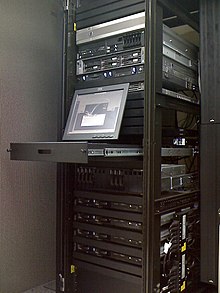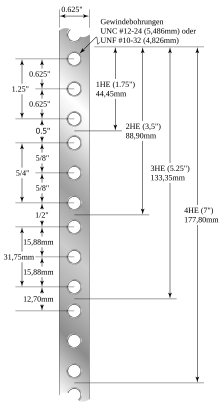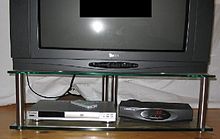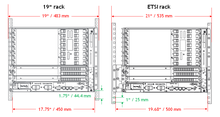Rack
The term rack ( English for "frame", "cabinet", "frame", "shelf" or "stand") is a term borrowed from English for a holding device that typically combines a number of smaller elements into a unit - such as z. B. a stand or a frame .
In electrical engineering, one generally speaks of a subrack .
19 inch racks
In data center operations and the event -, laboratory - and control technology , the term rack (Engl. 19-inch rack ) for a rack for electrical equipment with a standardized width of 19 inches , in which the individual devices ( "slots"), which in itself Have the rack mounted, have a front panel width of exactly 48.26 centimeters (≙ 19 ″) (e.g .: subrack ). A height unit (HE, in English also rack unit [U, rarely: RU]) is specified with 1.75 inches (≙ 4.445 cm), a division unit (TE) for the module width within a rack with 1/5 inch (≙ 5 , 08 mm).
The 19-inch rack system is standardized for good compatibility (EIA 310-D, IEC 60297 and DIN 41494 SC48D). The front panels of the plug-in units are therefore a multiple of a height unit, which corresponds to 1.75 inches. For some leeway during installation and especially removal, 1/32 inch (corresponds to 0.787 mm) are deducted from the front panels. The devices are fastened with four screws each in the rows of holes in vertical sheet metal angles near the front edges of the shelf. These sheets are about 2 mm thick (steel: at least 1.9 mm, aluminum: stronger) and each 5/8 inch (15.88 mm) wide and form a 450.85 mm (corresponds to 19 ″ minus 2 × 5 / 8 ″ = 17.75 ″) wide opening. The rows of holes have a horizontal center-to-center distance of 465.14 mm (18 5/16 ″). Per height unit (1.75 ″) there are three holes at two intervals of 15.88 mm (0.625 ″) one above the other, the distance to the first hole of the next height unit is slightly smaller at 12.70 mm (≙0.5 ″), see above the result is a visibly rhythmic repetition of the hole spacing. In the USA, the holes tend to have tapped holes: The fine # 10-32 (tpi) UNF (approx. 4.8 mm outer diameter) or the coarser UNC threads # 12-24 (approx. 5.5 mm) and 1 / 4 ″ (20 tpi) (6.35 mm), metric M5 or M6 are less common. It is more economical to equip the sheets with square or round punched holes into which snap - or cage nuts are only inserted when required.
When buying network cabinets, always pay attention to the dimensions of the devices to be installed. Cabinets are always specified in terms of their external width and external depth. Only the installation height is numbered in HE. For example, a 42 U 600 × 800 cabinet would be standard on the market. This means that the cabinet has a usable grid of 42 U, on the other hand 600 mm outside width and 800 mm outside depth. The usable inside width and inside depth varies from manufacturer to manufacturer and must be observed.
Information technology
Standard racks for data centers are around 2 meters high and usually offer a net space of 42 U. They are available in depths of 60, 80, 100 or 120 centimeters and widths of 60, 70 or 80 centimeters. The larger overall widths offer additional space on the side for structured cabling or for the power supply. The racks can be closed with side walls or doors to cabinets.
A slot for plug-in boards or modules in Eurocard format (100 × 160 mm ) is 3 U high and comprises 84 HP , which for the VMEbus , for example, offer space for up to 20 boards (4 HP are calculated per board), 2 TE required for the terminating resistors. The double euro format (233 × 160 mm) with 6 U is used for larger boards.
Sound and light technology
The use of devices that can be mounted in racks has also established itself in sound and lighting technology . They are mainly used in PA and studio technology, including for equalizers , power amplifiers , effects devices , channel strips and dynamics processors . Racks for the stage technology are designed as flight cases .
Trivia
The 19-inch rack system is an example of how a very cumbersome standard based on different prime numbers can evolve over time. In addition to the 19 "overall width of the horizontal part of unit 1 / are 5 and the vertical part unit" 7 /4 "also on primes based. The horizontal spacing of the mounting holes is 293 /16 ", while the clear width between the uprights 71 /4" is. The height unit is divided asymmetrically so that the vertical spacing of the mounting holes is based on prime numbers in the alternation with 1/2 ″ and 5/8 ″ described above .
In the standards (see above), some lengths that can be approximated in millimeters are also defined in these (e.g. 450 mm clearance between the bars and 465 mm mounting hole spacing).
Furniture
The term rack is also used for shelves for storing or presenting hi-fi and TV sets. These hi-fi racks or TV racks do not have standardized widths and are usually adapted to the look and size of the hi-fi devices. For the most part, materials such as stainless steel, aluminum, glass or wood are used to manufacture these racks.
Drum racks
A rack is a frame to which the individual parts of a drum kit are attached, mainly tom toms and cymbals , occasionally other instruments such as percussion and effect instruments .
Traditionally, a drum kit requires a large number of stands: at most one or a maximum of two tom toms can be attached to the kick drum , otherwise each cymbal and drum (with the exception of the kick drum) is mounted on its own stand, although the tom toms are often mounted in pairs ( two on a stand) or on fixed legs ( floor toms ) . This structure means that the drummer is surrounded by a tangle of stands, which can easily slip on a smooth surface. Since practically every stand has three feet, space is often tight, especially when microphones are also set up.
As an alternative to this conventional structure, the rack with just a few legs (two to four) offers the option of hanging a large number of individual instruments. For this purpose, the legs are connected with horizontal cross struts to which brackets for cymbals, drums and other instruments are screwed. The rack has established itself as the standard for electronic drums . The rack is also standard when using two bass drums .
More racks
- The International Standard Payload Rack is the installation base for research modules of the International Space Station (ISS).
- The mini rack or 10-inch rack is a narrower version of the 19-inch rack, which is usually less deep. It is primarily used in the private sector and in smaller installations. In some cases, even particularly small cabinets in a 19-inch grid are called mini-racks. Many cabinets are suitable for wall mounting.
- ETSI racks (= 535 mm) are defined by the European Telecommunications Standards Institute (ETS 300 119). The 535 mm refer to the outer distance of the frame bars; 19 inches refers to the length of the front panel of the device, which often corresponds to the outer distance of the frame bars. 535 mm is almost exactly 21 inches, which is why ETSI racks are sometimes referred to as 21-inch racks.
The clear width between the frame bars is 50 cm. 19-inch devices - a maximum of 45 cm wide - can easily be installed in an ETSI frame using adapters.
ETSI also standardized the external dimensions of the cabinets: four possible widths: 15/30/60/90 cm, two possible depths: 30/60 cm.
- 23-inch racks (= 584.2 mm) were introduced by Western Electric and are widely used in the telecommunications sector in America.
The mounting holes are 1 inch vertically center-to-center.
Web links
- Do-It-Yourself instructions for recording studio furniture using a rack as an example . Wikibooks
- Instructions for server cabinet selection
Individual evidence
- ↑ Ralph Göpel: Practical Guide VMware vSphere 6.7: Guide for installation, configuration and optimization . O'Reilly, ISBN 978-3-96010-289-2 .
- ↑ Sven Ahnert: Virtual machines with VMware and Microsoft: for development, training, testing and production . Pearson, ISBN 978-3-8273-2805-2 , pp. 25 .






